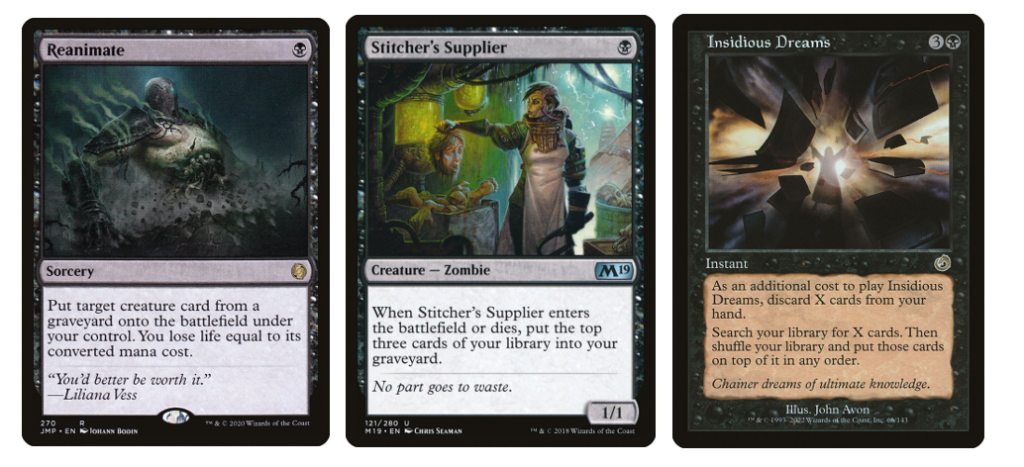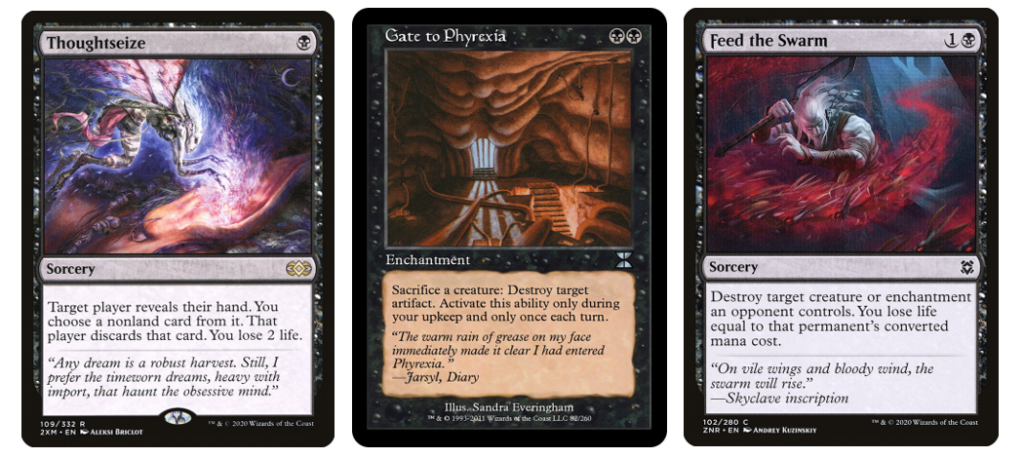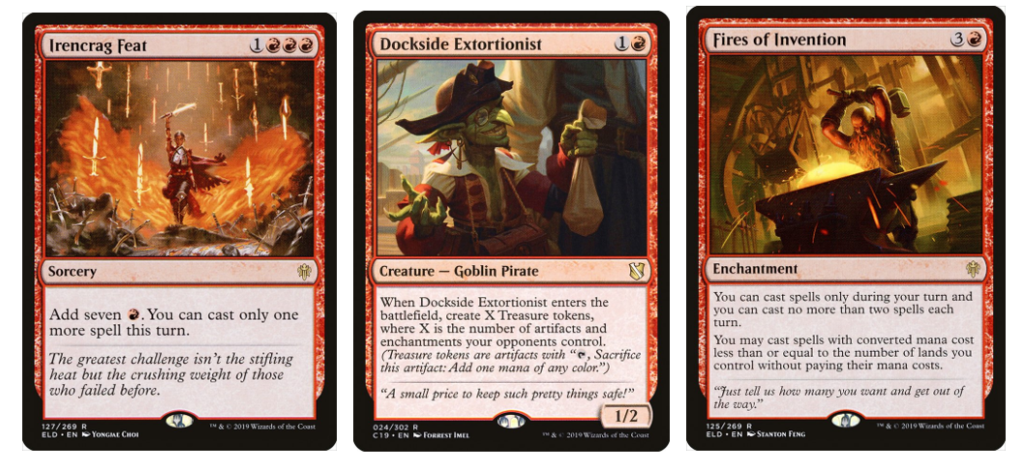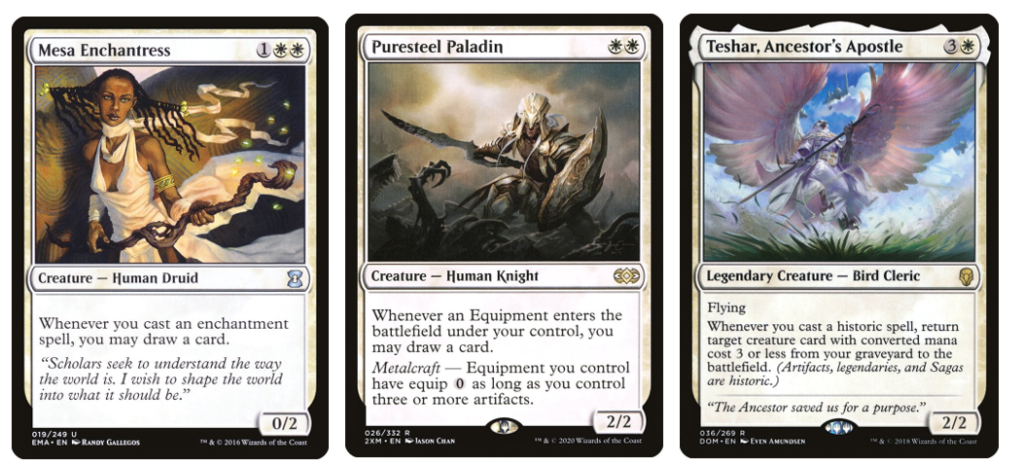Greetings, Commander connoisseurs!
I’m here to talk about playing mono-white Commander decks… and mono-red. Oh, and mono-black, too. These three are my favorite colors in Magic, and I don’t think there’s a more interesting way to explore what they’re capable of than by rising to the challenge and building entire Commander decks around them.
Generally speaking, color access is the most powerful advantage in Commander; for every color you cut out, you lose access to more staple cards players are used to leaning on. By the time you get down to a mono-color Commander, you’re missing out on whole families of effects outside your slice of the color pie.
But restrictions breed creativity, as brewing enthusiasts are fond of saying. Why else do we play a format with color identity rules in the first place! And not having access to as many of the usual “must-play” cards is a good way to justify finding cool, niche replacements — or employing clever deckbuilding to make up for the shortfalls.
KNOW YOUR STRENGTHS, COVER YOUR WEAKNESS

It is true that mono-white, mono-red and, to a lesser degree, mono-black are where these shortfalls hit the hardest. If you follow the old truism that Commander is about “cards plus mana,” these decks lack much in-color access to those resources. They also don’t have the freedom to easily sink spare cards and mana back into making more — the ramp and draw spells that allow blue and green players to constantly improve their position and use turns efficiently.
Instead, Mardu colors focus on removing enemy permanents, and often rely on damage for removal and pressure — not as efficient or convenient in 40-life multiplayer games. Crucially, their selection of instant effects is very limited, so they aren’t as able to hold up mana to defend themselves. Having to tap out on your own turn, whether to attack with your creatures or cast something at sorcery speed, will always be a massive liability against multiple opponents.
My approach to choosing tools for mono-color decks is to accept the limitations of the color, commander, and themes I’ve committed to. It’s about finding the best ways to operate in accordance with those limitations — playing the best version of your own deck instead of a lesser version of someone else’s. I’ve written before about how having an idea of your deck’s identity is one of three key factors to enjoying Commander; it’s also essential to finding ways you can make up for the weak points of your chosen color.
MONO-BLACK
Black enjoys some significant advantages over white and red and has few serious blind spots. This flexibility comes from the “Faustian bargain” design philosophy that gives black access to almost any effect in exchange for life and other resources. Notably, this includes a lot of efficient card draw to supplement its powerful tutors (Phyrexian Arena, Promise of Power, Necropotence).

While it lacks traditional mana dorks and land ramp, black has its own suite of mana-generating effects. Dark Ritual and its ilk offer explosive mana for combos or tempo plays, while Cabal Coffers, Black Market, Altar of Shadows, K’rrik, Son of Yawgmoth and Magus of the Coffers let you hugely outscale opposing mana production as the game goes on. Mono-color decks already have an advantage in this field thanks to Caged Sun, Gauntlet of Power and Extraplanar Lens, but black can take this to absurd levels with Crypt Ghast, Nirkana Revenant, and Liliana of the Dark Realms!

Paying life and sacrificing permanents as alternate costs also gets black ahead just by casting cheaper spells for similar impact. Black’s affinity for reanimation is its own path to winning the resource game; Reanimate on a huge creature is often as good as ramping into it, and adding cards to your graveyard (Stitcher’s Supplier) is generally cheaper than adding them to your hand. Sometimes you can even do it to pay the cost for a different effect (Insidious Dreams)!

While its instant-speed interaction is heavily slanted toward creature removal, EDH is heavily slanted toward creatures in the first place, so you at least have an effect that matters in most cases. Black also has hand interaction (Thoughtseize) — less useful than reactive effects in multiplayer, but at least it gives you some ability to disrupt hand-based plays and protect key spells from interaction. Black’s biggest weakness is how it struggles to remove artifacts and enchantments, with only a couple options for either (Gate to Phyrexia, Feed the Swarm). Fortunately, a range of colorless cards can answer this problem — and while they’re expensive, mono-black easily generates mana to pay for them (Karn Liberated, Scour From Existence).
Black can also have a rough time against tables which play Constructed-level graveyard hate, but it is possible to account for that in deckbuilding.
TIPS:
- Black tends to get bottlenecked on cards when it doesn’t have the mana to spend on them. Make sure to play mana sinks where you can, especially those which give you more cards to play (Phyrexian Reclamation, Erebos, God of the Dead).
- Try to squeeze as many life gain effects as you can (Disciple of Bolas, Tendrils of Corruption) into every black deck; the ability to pay life for power is black’s biggest asset, and all its best cards leverage that. Lifelink, especially on equipment like Basilisk Collar or Shadowspear, is often the most efficient way to repeatedly gain large sums of life.
- If you’re building your deck around utilizing the graveyard, make sure you’re goldfishing as you make changes to see how consistently you can get that engine up and running early. You need a good mix of cards to grow your yard (Stinkweed Imp, Altar of Dementia), reanimation spells, reanimation targets, and other payoffs (Crypt of Agadeem, Tombstone Stairwell). Playing cards that self-recur or guarantee value when they hit the yard is also a great safety valve.
MONO-RED
Mono-red’s position in Commander has improved dramatically in the past five years. Red now has consistent access to real card advantage through “impulse draw” and conditional “play the top of your deck” abilities to complement its draw-discard and Wheel spells. Red can easily generate mana advantage as well, be it through bursty rituals (Irencrag Feat), treasure tokens (Dockside Extortionist), “free spell”/polymorph effects (Fires of Invention, Tibalt’s Trickery), or the occasional outright mana dork/discounter/mana multiplier (Leyline Tyrant, Mana Echoes).

Red also enjoys artifact synergies that are nearly as strong as blue’s, and the range of powerful artifacts available can further offset the holes in its gameplan (Chaos Wand, Staff of Domination). Nevertheless, those holes themselves are more serious than what we see in black, meaningfully limiting how red decks can play the game.

A huge chunk of red’s best cards are designed around mana efficiency at the cost of card efficiency, and proactively dealing damage to opponents — neither of which are really strengths in multiplayer Commander. While burn spells can be used as creature removal, they are the easiest to defend against, and they scale poorly with the threats in the format. The high life totals and inability to safely throw everything at one foe robs these spells of the flexibility that makes them good in the first place.
Even the most efficient aggro creatures tend not to be worth a card in Commander, unless they offer a mana sink or other scaling effect like prowess. In general, damage-based threats in Commander tend to do one of two things: they efficiently take huge bites out of opponents turn after turn, or they kill the whole table in one go. Red struggles to do either.

Red shares black’s difficulty in handling enchantments, although it is plenty capable of killing artifacts. Luckily, it does have a strong selection of unconventional tricks to deal with enchantments or indestructible creatures — from polymorph effects (Chaos Warp, Indomitable Creativity), to stealing and sacrifice permanents (Word of Seizing, Zealous Conscripts), to transforming them into more manageable card types (Distorting Lens, Liquimetal Coating).
TIPS:
- Red’s instant-speed interaction isn’t great, but it tends to get better in high-powered metagames. This is thanks to the increased importance of blue spells and artifacts; as in Legacy, red’s access to Pyroblast, Red Elemental Blast, and even Fork effects becomes highly relevant when games are decided on the stack.
- Red’s access to burst mana from rituals and its powerful card selection from looting and Wheels means it’s sneakily one of the best mono-color options for combo kills. You can use powerful artifact recursion like Scrap Trawler to instantly assemble multi-part engines like the Mirrodin-era Stations or Kaladesh Modules. There are also iconic red combos like Splinter Twin/Kiki-Jiki, Mirror Breaker + Zealous Conscripts, Godo, Bandit Warlord + Helm of the Host, or Bonus Round + Storm spells.
- If you do decide to go aggressive with creatures or burn, make sure you fully utilize the political potential of being the first, fastest threat. Curry favor by rushing down the combo or control player, then use the threat of burn spells to encourage other players to do your bidding! Red’s ability to attack mana — through artifact removal, land destruction or Blood Moon — is also best used as a bargaining chip instead of a bludgeon.
MONO-WHITE
Much maligned (and much beloved by its fans), white’s position as the “fair” color of Magic leaves it in the weakest position as a mono-color Commander choice. Even after years of attempts to redress the problem, the power ceiling on white’s key effects is still lower than that of other colors, and its slice of the color pie hasn’t broadened in the same way that other colors’ have.
Of course, that doesn’t mean it’s impossible to build a fun or powerful mono-white deck. But you will have less choice in how to do so than in other colors, and most options are either highly linear, unpopular with the general player base, heavily reliant on a specific commander, or all of the above.

White has very little card advantage in-color, even compared to red or black. Its few efficient, reusable options depend on synergy with specific card types (Mesa Enchantress, Puresteel Paladin), and as such, many mono-white decks (Sram, Senior Edificer, Teshar, Ancestor’s Apostle) start by committing to a focus on one such “package” of synergies.
While it is possible to rely on artifacts to patch the holes, it’s harder here because white is also dead last in the mana advantage race. Smothering Tithe and Serra’s Sanctum are the only big mana engines, and both can be expensive to add to your collection. Cram in all the mana rocks you can find and dig for alternate cost cards, particularly mechanics like convoke that let you generate mana without sacrificing extra cards.

Lack of resources and card selection make it tricky for white to win through individual haymakers or killer combos — but you can still force the pace and go under them! White aggro has a much better time in Commander than red aggro for a number of reasons. Its affinity for auras and equipment makes it a great choice for a Voltron deck — one of the few aggro plans that scales well into multiplayer games. Good equipment also helps aggro decks go the distance, since even when one threat dies, the next weenie can pick up its pile of swords and keep the pressure on.

If you can generate early creature pressure and force opponents to fight on those terms, protection spells (Gods Willing, Akroma’s Will) will grant you a powerful instant interaction game that can lead to lethal blowouts. And if opponents don’t defend themselves, you unlock team-pump and tribal effects (Dictate of Heliod, Charge Across the Araba) as your own resource-efficient answer to combo kills. Meanwhile, white’s easy access to vigilance, life gain, and pillowfort effects (Ghostly Prison, Worship) make a tap-out attack less risky.

When you do need to go for a longer gameplan in white, you can turn to its deep pool of recursion and defensive effects to help. Compared to black, white is much more likely to return cards from their graveyard to hand than to the battlefield. When it does directly reanimate things, white’s options are limited to small permanents or those that died recently. But either way, these effects tend to be re-usable. Over time, it is possible to claw back card and mana advantage through effects like Sun Titan, Emeria, the Sky Ruin, and Enduring Renewal. If you can get them into your graveyard somehow, recursion effects like Trove Warden and Planar Birth can even help fix your ramp problems.
Pillowfort effects that make it difficult to target you and your permanents will buy you time to set up and protect the pieces of this engine. Being the sluggishly slow white deck already makes you a low-priority target to most foes, and once they have to get through four different enchantments to deal damage, almost none of them will bother to commit to it.
TIPS:
- There’s a whole range of white cards that can put lands into play or cards in your hand, but only function if you have fewer lands than your opponents. If you can build your deck to intentionally create those conditions (bounce lands, lands that sacrifice themselves, and mana rocks are your friends!), then you can suddenly unlock the might of cards like Land Tax and Oath of Lieges.
- White’s lack of generic resource advantage and efficiency means you should almost always narrow your card selection to benefit from a specific set of synergies. If you can pick a Commander who further multiplies that efficiency, so much the better. Go-wide tokens, creature tribes, enchantments, artifacts, equipment and auras, lifegain, and +1/+1 counters make up most of your best choices.
- Many of white’s strongest cards in a high-powered meta are static, defensive effects like Rest in Peace or Solitary Confinement, while its viable card advantage options shrink even further. Try to pick a Commander that’s aggressive in combat, provides a mana sink, or draws you cards so you can still be proactive as required.
A FINAL NOTE ON MARDU DIPLOMACY
One big reason why these colors aren’t more popular in Commander is that they inherently lead you to play a confrontational, interactive type of game. Many of the double-sided effects that the colors have access to are about limiting how your opponents can play. The weakness of the late game and reactive effects in these colors force the mono-Mardu player to remove permanents proactively, declare pre-emptive early game attacks, play “hate cards” that restrict opponents’ options, and generally make enemies at the table.
In more casual circles where Commander is a game about getting to do the cool thing your deck does, you are going to be the person trying to stop people from doing their cool thing whenever possible. Not everyone wants to risk annoying their friends this way, or getting ganged up on because their effects hurt all players at once.
But I believe there’s a mono-Mardu deck for every table. If you talk to your playgroup to set some expectations first, they will hopefully understand why you want to start attacking early, turn every land into a Mountain, or block their extra card draw. It’s just a different playstyle, and one that isn’t really harder to work through than counterspells, board wipes and other reactive effects. Every Commander deck can play a few more pieces of artifact and enchantment removal or learn to hold counterspells for Armageddon the way you would Cyclonic Rift or an Exquisite Blood combo — and so they should.
But trust-building around these cards is a two-way street. Try to make sure you have reliable win conditions (Test of Endurance, Heliod, Sun-Crowned + Walking Ballista), so you can end the game before people get bored. Also, talk to your group or play with another deck first to gauge the power level. If you don’t think your table wants to play against Winter Orb or Trinisphere, try Sphere of Safety and Price of Glory first!

I hope that these tips have provided you all with the motivation and confidence to build the mono-color deck of your dreams, along with the political and strategic nous to make it work as part of your personal metagame. But if your first draft doesn’t work, keep trying — persistence and strength in numbers are the great shared strength of white, black, and red, after all.

Tom’s fate was sealed in 7th grade when his friend lent him a pile of commons to play Magic. He quickly picked up Boros and Orzhov decks in Ravnica block and has remained a staunch white magician ever since. A fan of all Constructed formats, he enjoys studying the history of the tournament meta. He specializes in midrange decks, especially Death & Taxes and Martyr Proc. One day, he swears he will win an MCQ with Evershrike. Ask him how at @AWanderingBard, or watch him stream Magic at twitch.tv/TheWanderingBard.

